On the Road is a weekday feature spotlighting reader photo submissions.
From the exotic to the familiar, whether you’re traveling or in your own backyard, we would love to see the world through your eyes.
If you woke up this morning, tired of this timeline and wishing you could be in another world, your wish has been granted. :-) We are mostly underwater this morning, but not in the bad way! ~WaterGirl
lashonharangue
One of my favorite places to scuba dive is Socorro Island in Mexico. It is the largest of a series of small volcanic islands about 250 miles S-SW of Cabo San Lucas off the tip of Baja. A large shield volcano rising out of the deep Pacific, the island attracts large marine life that live in the open ocean: hammerhead sharks, whale sharks, dolphins, and manta rays.
To get there you book a cabin on a live-aboard dive boat which takes 24-26 hours to reach Socorro from Cabo. You can do up to five dives a day off the boat (it isn’t permitted to go ashore). The boat holds about 20 divers.
Over the course of a week the boat visits several different locations around Socorro and two other islands in the Revillagigedo archipelago. Each island is the top of a volcano rising from a submerged mountain ridge. Socorro has had eruptions in the relatively recent past.
Some locations are pretty easy diving while others have moderate current. Before diving each location, the divemaster reviews a map of the location drawn on a whiteboard. Most dives are at a depth between 40 and 80 feet.
The manta rays that frequent the islands often swim over to check out the divers. It isn’t possible to keep pace with the mantas so the encounters are totally on their terms. Each one has unique markings. See if you can spot the differences.
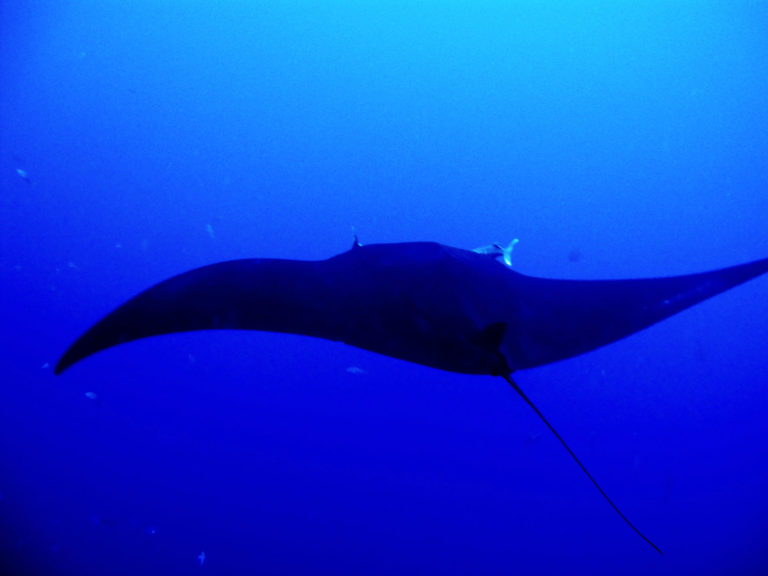
This is a view from slightly above. It is hard to judge size underwater. But the mantas we saw were probably about 15-17 feet wingtip to wingtip. Manta rays are related to sharks (cartilaginous fishes) but are filter feeders that eat plankton suspended in the water.
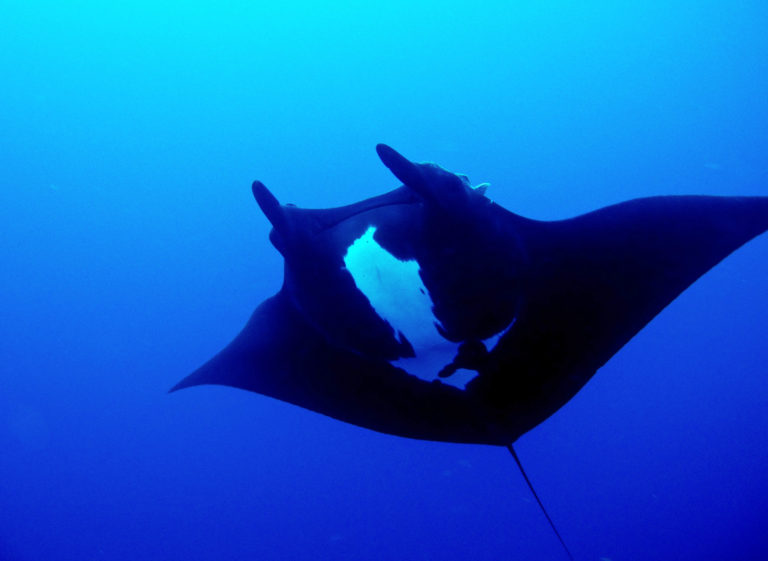
I think this was a companion swimming with the manta in the previous photo. We usually encountered more than one manta at a time. Unfortunately, still photos can’t convey how graceful these animals are moving through the water – like slow motion birds.
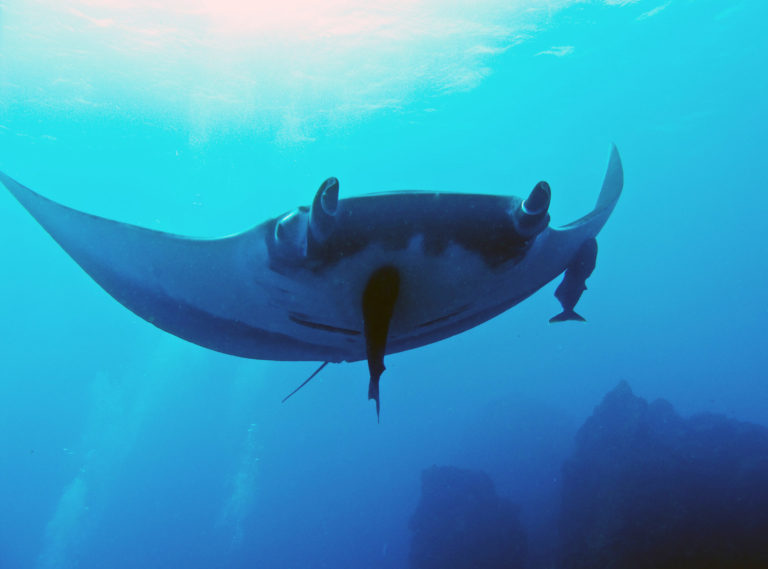
These are remoras (suckerfishes) attached to the manta. I think we saw at least one on each manta we encountered. My understanding is they don’t impact the health of the mantas, as they are not really parasites – more like freeloaders getting protection and transportation.
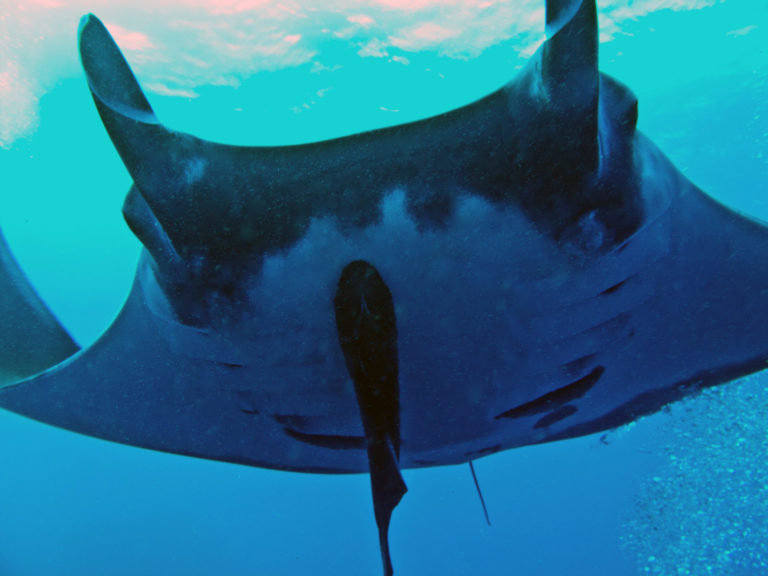
This is the same manta up close, not a zoom. Sometimes a manta will swim directly over a diver and can be touched without being spooked. Their skin is somewhat rough in texture. Why they are willing to get so close is unclear. One theory is they enjoy the feel of the divers’ exhaust bubbles.
This is very different from the behavior of hammerhead sharks. If you have seen good photography of them the diver was probably freediving or using rebreather equipment that doesn’t create bubbles. We saw a few hammerheads but always at a distance.
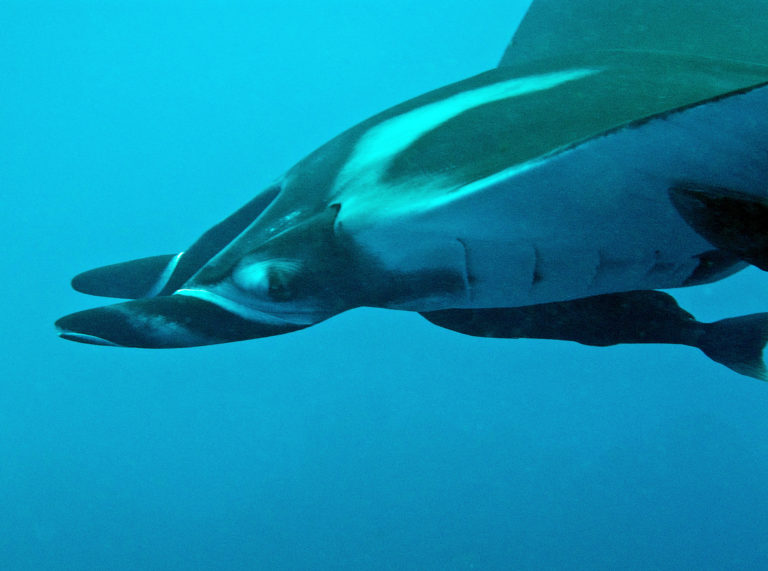
This manta had a very distinct pattern on the dorsal side.
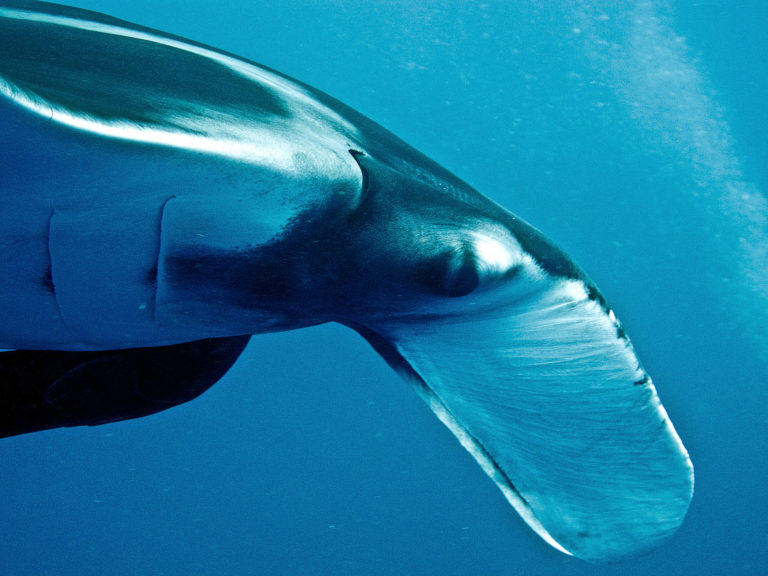
Manta rays have large eyes. When this one swam by it looked me over. I had the distinct impression of a consciousness there – kind of like meeting an ET. Not something I’ve felt from being close to other fishes. Manta rays have the largest brain of any fish. https://oceana.org/blog/manta-ray-brainpower-blows-other-fish-out-water-10
The divemaster told us about some research done by marine biologists. Can’t confirm his account but I can imagine it’s true. He said a group of similarly sized divers wore different colored dive gear. One interacted with a specific manta ray. The divers surfaced and then did another dive after exchanging their gear among themselves. Unprompted, the manta picked out the diver it had previously interacted with.
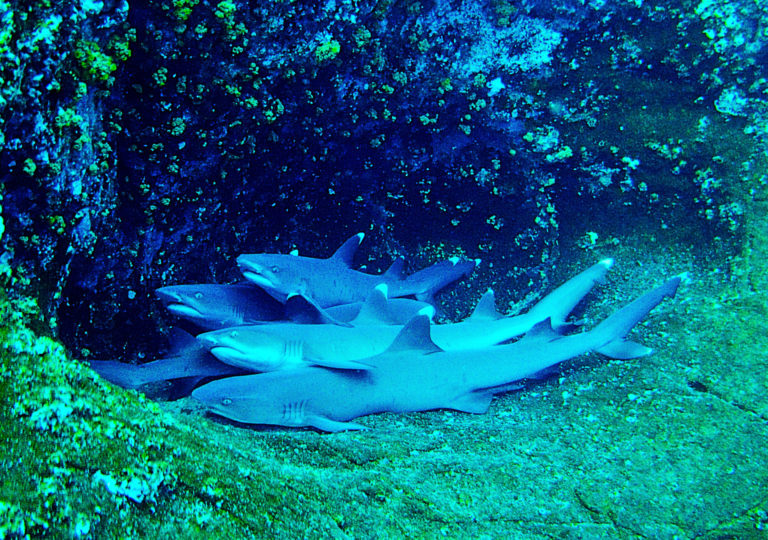
There is more marine life to see at the islands than just manta rays. We were diving on a vertical wall and saw this group of five white tip sharks resting like a pile of puppies on a ledge. The idea that all sharks need to keep moving to breath is not correct. It depends on the species.
This photograph was taken by getting below the ledge and then slowly rising up to the edge – about five feet away. The sharks were about 3-4 feet in length and didn’t react. On this same dive we also saw dolphins, mantas, and a whale shark. Wow!

Sab
“Related to sharks”. I did not know that. Thanks.
Cermet
Saw a whale shark! Lucky!
Mary G
I used to love scuba diving. Been a long time since I did it and was off Little Harbor on the back of Catalina Island with much smaller creatures. Lots of garibaldis or similar pretty orange fishes. There were wild buffalo whose ancestors had been brought over to make movies and abandoned after their work was done. Woke up one morning to find a baby quail in my shoe. Nice memory, thanks for reminding me of it.
JPL
The pictures are great and thank you for sharing.
p.a.
Thanks!
lashonharangue
@Mary G: Garibaldis – the state marine fish of CA! I have been diving at Catalina a few times. They are not big fish but I have seen them attack the lens of a camera that got too close to their eggs deposited on a rock.
Yutsano
Remoras (remorae?) are harmless to their host fish. In fact, they may even be beneficial.
gkoutnik
Oooh – a tropical island I’ve never heard of in the middle of the Pacific (OK, not actually the middle) that you can’t go to! Dinosaurs? Half-man, half-beast? Sci-fi has prepared me for this !
We love snorkeling – beauty, flying, calm, different world – but have never scuba dived. Thanks for the pics!
Amir Khalid
Off-topic, but when does the morning open thread go up?
raven
Awesome.
Le Comte de Monte Cristo, fka Edmund Dantes
I’ve never gotten to see a manta on any dive. We have a trip to Fiji set up for next June, so it may be a possibility.
Very cool photo set!
Jay Noble
Some nature show I saw long ago said they found that the sharks that weren’t moving were sitting in currents that did the work – breathing – that moving did.
eclare
Wow! Great photos!
Wag
Amazing. Thank you
There go two miscreants
These are great! Other than videos, I’ve only seen mantas in motion at the aquarium but even in that confined space they are amazing.
MoxieM
stunning!! thank you
Emma
Mantas are awesome, thanks for the photos!
StringOnAStick
Oh, such gorgeous photos, thank you, thank you, thank you!!!! I can’t scuba dive or just dive anymore thanks to a partially detached ear drum, but I loved it when I did. I have a custom fitted ear plug so I can snorkel and swim without filling my right inner ear with water.
When we were on a small boat headed to the western Galapagos a huge manta near the surface did a quick move to vertical to slide past our boat and then both wingtips broke the surface in the boat wake as it went back to horizontal. Everyone who saw it was open mouthed at how huge it was; one of the most exciting things I’ve even seen. Thanks for such lovely photos of such amazing creatures!
sherparick
Thanks for the photographs. They help make the day.
BigJimSlade
Wonderful post! I’ve seen some small rays while snorkeling off of Caye Caulker (Belize, 25 years ago) – one jumped out of the water and hit it again with a SLAP!
J R in WV
While in the Navy at Key West, I discovered that I could rent a little outboard at the EM club. So we bought masks and snorkels and went diving out on the reef. Then a shipmate had a sudden need for cash to pay a lawyer, and sold me a single tank diving rig. A chief I worked for had a buddy at the UDT school who worked on dive equipment and rebuilt my regulator for $18 in parts. I picked up a copy of the USN Divers Handbook and read it pretty intensively.
So then I got to fly among the coral cliffs. Saw all the typical things. Only scary part was that there are a lot of barracuda around the Keys, but was taught that being smooth and regular in motion would keep from attracting their attention, which proved to be true.
While running the little outboard quite near the island itself, we did see a huge manta ray leap out of the ocean, it appeared to be at least a big as the little boat! Amazed, so sudden there he was, then with hardly a splash, gone again.
So thanks so much for these photos!! Reminding me of adventures long ago when I was young and strong and in the salt water a lot
JustRuss
Great pics. did a little diving when I lived in Hawaii, no mantas but lots of encounters with big turtles.
lashonharangue
@JustRuss: If you go to the Big Island you can see mantas. Unfortunately I found it a disappointing experience. Several dive boats from Kona take dozens of divers to a spot at night. Everyone sinks to the bottom and shines their lights up. This attracts the phytoplankton and the mantas come around to feed above you.
way2blue
15- to 17-ft wingspan. Yikes.. So many questions… Is their shovel-shaped front designed to scoop in plankton?
A couple years ago, my husband & I snorkeled amongst juvenile whale sharks in a preserve off La Paz, Baja Sur. Astonishing creatures. Thanks for giving us a glimpse of such a remote dive site.
lashonharangue
@way2blue: None of these photos show them feeding. Their mouth opens into a big oval.